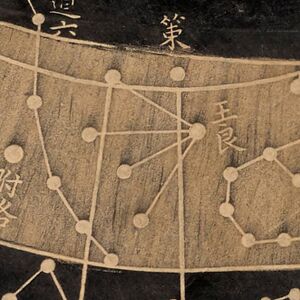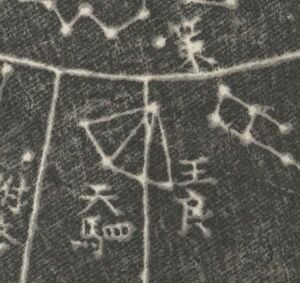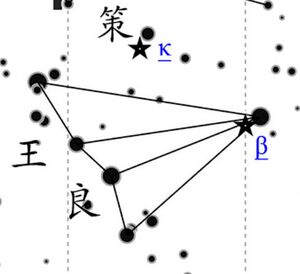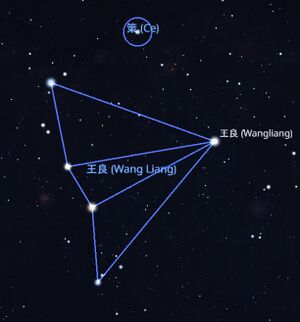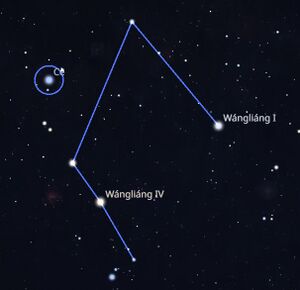Ce: Difference between revisions
Boshunyang (talk | contribs) mNo edit summary |
Boshunyang (talk | contribs) mNo edit summary |
||
| Line 1: | Line 1: | ||
{{DISPLAYTITLE: Ce (策)}} |
{{DISPLAYTITLE: Ce (策)}} |
||
[[File:(Left) The end of jade horsewhip in late Shang and early Zhou dynasty and (Right) the demonstration of the horsewhip.jpg|thumb|(Left) The end of jade horsewhip in late Shang and early Zhou dynasty and (Right) the demonstration of the horsewhip. (credit: Palace Museum in Taiwan)]] |
|||
Cè (Whip, 策) is a Chinese star name representing the horsewhip, located beside the asterism ''[[Wangliang]]'' and closely associated with both ''[[Wangliang]]'' and ''[[Tiansi]]''. It belongs to the Gān school. |
Cè (Whip, 策) is a Chinese star name representing the horsewhip, located beside the asterism ''[[Wangliang]]'' and closely associated with both ''[[Wangliang]]'' and ''[[Tiansi]]''. It belongs to the Gān school. The ancients sometimes also call it '''Cexing''' (whip star) or '''Tiance''' (celestial whip). |
||
== Concordance, Etymology, History == |
== Concordance, Etymology, History == |
||
Revision as of 11:12, 9 November 2025
Cè (Whip, 策) is a Chinese star name representing the horsewhip, located beside the asterism Wangliang (王良) and closely associated with both Wangliang (王良) and Tiansi (天駟). It belongs to the Gān school. The ancients sometimes also call it Cexing (whip star) or Tiance (celestial whip).
Concordance, Etymology, History
The original meaning of ce refers to a bamboo horsewhip with a pointed tip, and as a verb it can mean “to whip” or “to drive.” In the Tiangaun shu (Book of Heaven Officials, 天官書)of the Western Han, it is said that “When Wang Liang drives his horses, the (war) chariots will fill the fields.” It is uncertain whether the Ce star had already been defined when this divinatory statement was composed (since the Gān Star Catalogue was completed around the same time or slightly later than Sima Qian’s work). However, the Eastern Han scholar Song Jun connected the phenomenon of “driving horses” with the Ce star, writing: “The Ce star is beside Wang Liang; if it moves ahead of Wang Liang, behind the horses, this is called ‘driving the horses.’” A Tang commentary in the Kaiyuan zhanjing adds: “There is a star beside Wang Liang called Ce; ‘driving the horses’ means that this star shines brightly.” These differing interpretations reflect what was considered an anomalous phenomenon in ancient Chinese stellar divination—namely, the apparent motion or brightness variation of a fixed star.
Identification of stars
| Star Names | Yi Shitong[1]
Based on catalogue in 18th century |
Pan Nai[2]
based on Xinyixiangfayao Star Map and Huangyou Catalogue |
SUN X. & J. Kistemaker[3]
Han Dynasty |
Boshun Yang[4]
before Tang dynasty |
Boshun Yang[4]
Song Jingyou(1034) |
|---|---|---|---|---|---|
| Ce | gamma Cas | kappa Cas | kappa Cas | kappa Cas | kappa Cas |
Maps (Gallery)
The Ganshi zan (Annotations of Master Gan) states: “Ce resides at the right of thr charioter.” This description is not entirely precise, as Ce is most likely refers to the Kappa Cas, the only bright star at the right side of Wang Liang and horses (relative to the forward direction of the horses), which located to the front-right of the charioteer (Wang Liang). Nevertheless, in several historical star maps, Ce is indeed drawn to the right of Wang Liang, showing a certain conceptual consistency.
| historical map | modern identification
(Yang 2023) |
same in Stellarium 24.4 |
|---|---|---|
Star Name Discussion (IAU)
In 202x, the name of the historical constellation "xxx" was suggested to be used for one of the stars in this constellation. ...
Decision: ...
References
- ↑ Yi Shitong伊世同. Zhongxi Duizhao Hengxing Tubiao中西对照恒星图表1950. Beijing: Science Press.1981: 56.
- ↑ Pan Nai潘鼐. Zhongguo Hengxing Guance shi中国恒星观测史[M]. Shanghai: Xuelin Pree. 1989. p226.
- ↑ Sun Xiaochun. & Kistemaker J. The Chinese sky during the Han. Leiden: Brill. 1997, Pp241-6.
- ↑ 4.0 4.1 B.-S. Yang杨伯顺, Zhongguo Chuantong Hengxing Guance Jingdu ji Xingguan Yanbian Yanjiu 中国传统恒星观测精度及星官演变研究 (A Research on the Accuracy of Chinese Traditional Star Observation and the Evolution of Constellations), PhD thesis, (Hefei: University of Science and Technology of China, 2023). 261.

